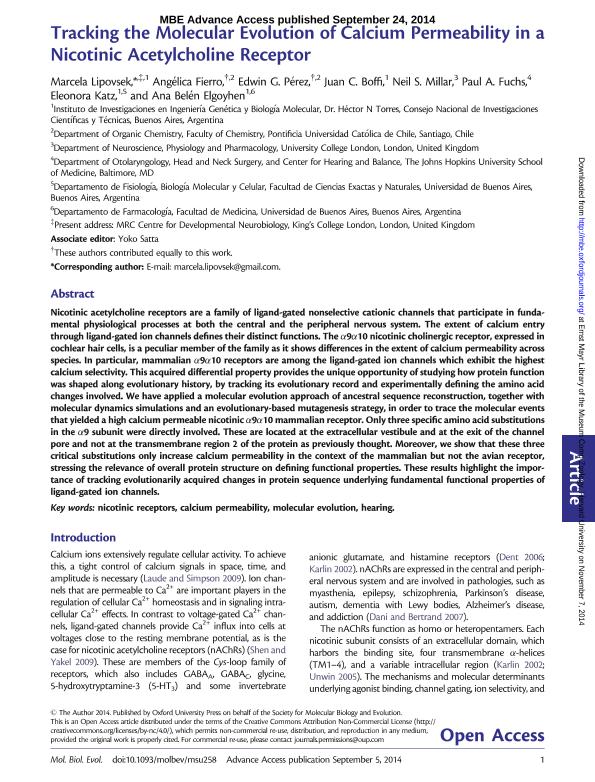Mostrar el registro sencillo del ítem
dc.contributor.author
Lipovsek, Maria Marcela

dc.contributor.author
Fierro, Angélica
dc.contributor.author
Perez, Edwin G.
dc.contributor.author
Boffi, Juan Carlos

dc.contributor.author
Millar, Neil S.
dc.contributor.author
Fuchs, Paul A.
dc.contributor.author
Katz, Eleonora

dc.contributor.author
Elgoyhen, Ana Belen

dc.date.available
2018-02-07T17:23:57Z
dc.date.issued
2014-09
dc.identifier.citation
Lipovsek, Maria Marcela; Fierro, Angélica ; Perez, Edwin G.; Boffi, Juan Carlos; Millar, Neil S. ; et al.; Tracking the Molecular Evolution of Calcium Permeability in a Nicotinic Acetylcholine Receptor; Oxford University Press; Molecular Biology and Evolution; 31; 12; 9-2014; 3250-3265
dc.identifier.issn
0737-4038
dc.identifier.uri
http://hdl.handle.net/11336/35966
dc.description.abstract
Nicotinic acetylcholine receptors are a family of ligand-gated nonselective cationic channels that participate in fundamental physiological processes at both the central and the peripheral nervous system. The extent of calcium entry through ligand-gated ion channels defines their distinct functions. The α9α10 nicotinic cholinergic receptor, expressed in cochlear hair cells, is a peculiar member of the family as it shows differences in the extent of calcium permeability across species. In particular, mammalian α9α10 receptors are among the ligand-gated ion channels which exhibit the highest calcium selectivity. This acquired differential property provides the unique opportunity of studying how protein function was shaped along evolutionary history, by tracking its evolutionary record and experimentally defining the amino acid changes involved. We have applied a molecular evolution approach of ancestral sequence reconstruction, together with molecular dynamics simulations and an evolutionary-based mutagenesis strategy, in order to trace the molecular events that yielded a high calcium permeable nicotinic α9α10 mammalian receptor. Only three specific amino acid substitutions in the α9 subunit were directly involved. These are located at the extracellular vestibule and at the exit of the channel pore and not at the transmembrane region 2 of the protein as previously thought. Moreover, we show that these three critical substitutions only increase calcium permeability in the context of the mammalian but not the avian receptor, stressing the relevance of overall protein structure on defining functional properties. These results highlight the importance of tracking evolutionarily acquired changes in protein sequence underlying fundamental functional properties of ligand-gated ion channels.
dc.format
application/pdf
dc.language.iso
eng
dc.publisher
Oxford University Press

dc.rights
info:eu-repo/semantics/openAccess
dc.rights.uri
https://creativecommons.org/licenses/by-nc-sa/2.5/ar/
dc.subject
Nicotinic Receptors
dc.subject
Calcium Permeability
dc.subject
Molecular Evolution
dc.subject
Hearing
dc.subject.classification
Otras Ciencias Biológicas

dc.subject.classification
Ciencias Biológicas

dc.subject.classification
CIENCIAS NATURALES Y EXACTAS

dc.title
Tracking the Molecular Evolution of Calcium Permeability in a Nicotinic Acetylcholine Receptor
dc.type
info:eu-repo/semantics/article
dc.type
info:ar-repo/semantics/artículo
dc.type
info:eu-repo/semantics/publishedVersion
dc.date.updated
2018-02-06T20:10:22Z
dc.journal.volume
31
dc.journal.number
12
dc.journal.pagination
3250-3265
dc.journal.pais
Reino Unido

dc.journal.ciudad
Oxford
dc.description.fil
Fil: Lipovsek, Maria Marcela. Consejo Nacional de Investigaciones Científicas y Técnicas. Instituto de Investigaciones en Ingeniería Genética y Biología Molecular ; Argentina
dc.description.fil
Fil: Fierro, Angélica. Pontificia Universidad Católica de Chile; Chile
dc.description.fil
Fil: Perez, Edwin G.. Pontificia Universidad Católica de Chile; Chile
dc.description.fil
Fil: Boffi, Juan Carlos. Consejo Nacional de Investigaciones Científicas y Técnicas. Instituto de Investigaciones en Ingeniería Genética y Biología Molecular ; Argentina
dc.description.fil
Fil: Millar, Neil S.. University College London; Estados Unidos
dc.description.fil
Fil: Fuchs, Paul A.. University Johns Hopkins; Estados Unidos
dc.description.fil
Fil: Katz, Eleonora. Universidad de Buenos Aires. Facultad de Ciencias Exactas y Naturales. Departamento de Fisiología, Biología Molecular y Celular; Argentina. Consejo Nacional de Investigaciones Científicas y Técnicas. Instituto de Investigaciones en Ingeniería Genética y Biología Molecular ; Argentina
dc.description.fil
Fil: Elgoyhen, Ana Belen. Universidad de Buenos Aires. Facultad de Medicina. Departamento de Farmacología; Argentina. Consejo Nacional de Investigaciones Científicas y Técnicas. Instituto de Investigaciones en Ingeniería Genética y Biología Molecular ; Argentina
dc.journal.title
Molecular Biology and Evolution

dc.relation.alternativeid
info:eu-repo/semantics/altIdentifier/doi/http://dx.doi.org/10.1093/molbev/msu258
dc.relation.alternativeid
info:eu-repo/semantics/altIdentifier/url/https://academic.oup.com/mbe/article/31/12/3250/2925689
Archivos asociados
